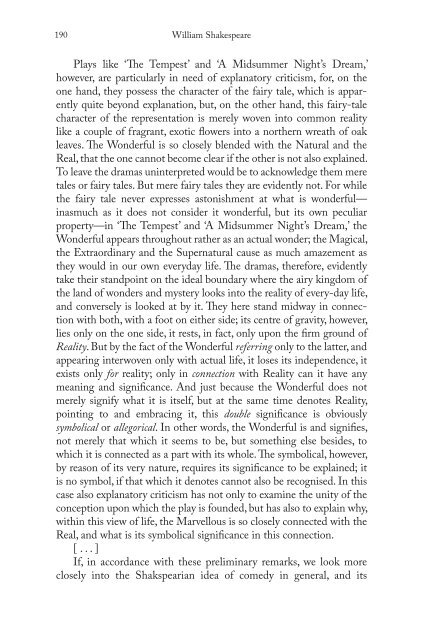Blooms Literary Themes - THE TRICKSTER.pdf - ymerleksi - home
Blooms Literary Themes - THE TRICKSTER.pdf - ymerleksi - home
Blooms Literary Themes - THE TRICKSTER.pdf - ymerleksi - home
You also want an ePaper? Increase the reach of your titles
YUMPU automatically turns print PDFs into web optimized ePapers that Google loves.
190<br />
William Shakespeare<br />
Plays like ‘Th e Tempest’ and ‘A Midsummer Night’s Dream,’<br />
however, are particularly in need of explanatory criticism, for, on the<br />
one hand, they possess the character of the fairy tale, which is apparently<br />
quite beyond explanation, but, on the other hand, this fairy-tale<br />
character of the representation is merely woven into common reality<br />
like a couple of fragrant, exotic fl owers into a northern wreath of oak<br />
leaves. Th e Wonderful is so closely blended with the Natural and the<br />
Real, that the one cannot become clear if the other is not also explained.<br />
To leave the dramas uninterpreted would be to acknowledge them mere<br />
tales or fairy tales. But mere fairy tales they are evidently not. For while<br />
the fairy tale never expresses astonishment at what is wonderful—<br />
inasmuch as it does not consider it wonderful, but its own peculiar<br />
property—in ‘Th e Tempest’ and ‘A Midsummer Night’s Dream,’ the<br />
Wonderful appears throughout rather as an actual wonder; the Magical,<br />
the Extraordinary and the Supernatural cause as much amazement as<br />
they would in our own everyday life. Th e dramas, therefore, evidently<br />
take their standpoint on the ideal boundary where the airy kingdom of<br />
the land of wonders and mystery looks into the reality of every-day life,<br />
and conversely is looked at by it. Th ey here stand midway in connection<br />
with both, with a foot on either side; its centre of gravity, however,<br />
lies only on the one side, it rests, in fact, only upon the fi rm ground of<br />
Reality. But by the fact of the Wonderful referring only to the latter, and<br />
appearing interwoven only with actual life, it loses its independence, it<br />
exists only for reality; only in connection with Reality can it have any<br />
meaning and signifi cance. And just because the Wonderful does not<br />
merely signify what it is itself, but at the same time denotes Reality,<br />
pointing to and embracing it, this double signifi cance is obviously<br />
symbolical or allegorical. In other words, the Wonderful is and signifi es,<br />
not merely that which it seems to be, but something else besides, to<br />
which it is connected as a part with its whole. Th e symbolical, however,<br />
by reason of its very nature, requires its signifi cance to be explained; it<br />
is no symbol, if that which it denotes cannot also be recognised. In this<br />
case also explanatory criticism has not only to examine the unity of the<br />
conception upon which the play is founded, but has also to explain why,<br />
within this view of life, the Marvellous is so closely connected with the<br />
Real, and what is its symbolical signifi cance in this connection.<br />
[ . . . ]<br />
If, in accordance with these preliminary remarks, we look more<br />
closely into the Shakspearian idea of comedy in general, and its

















